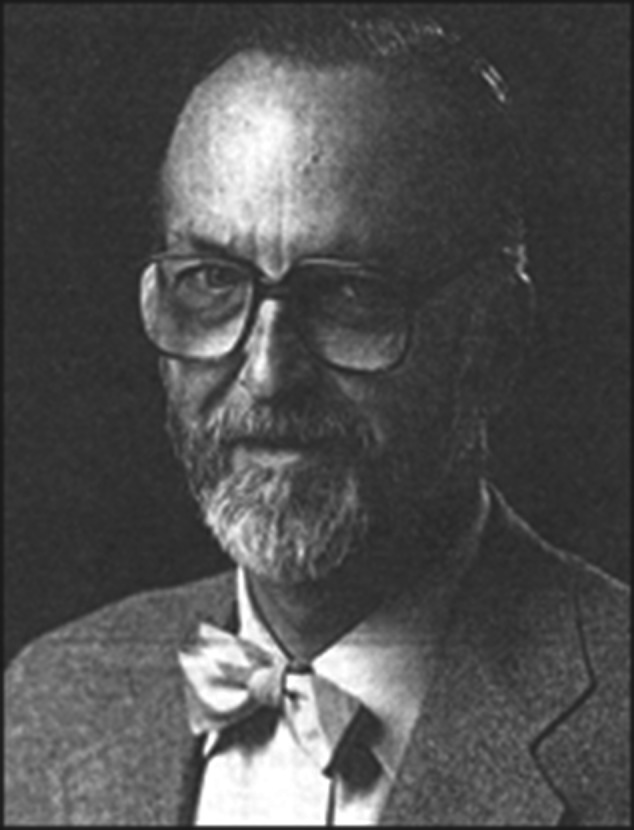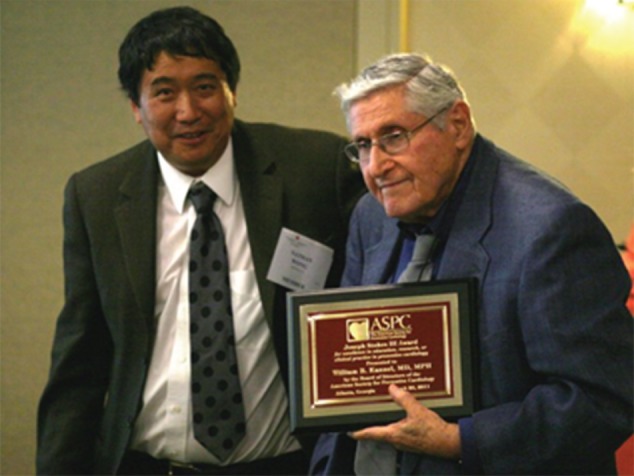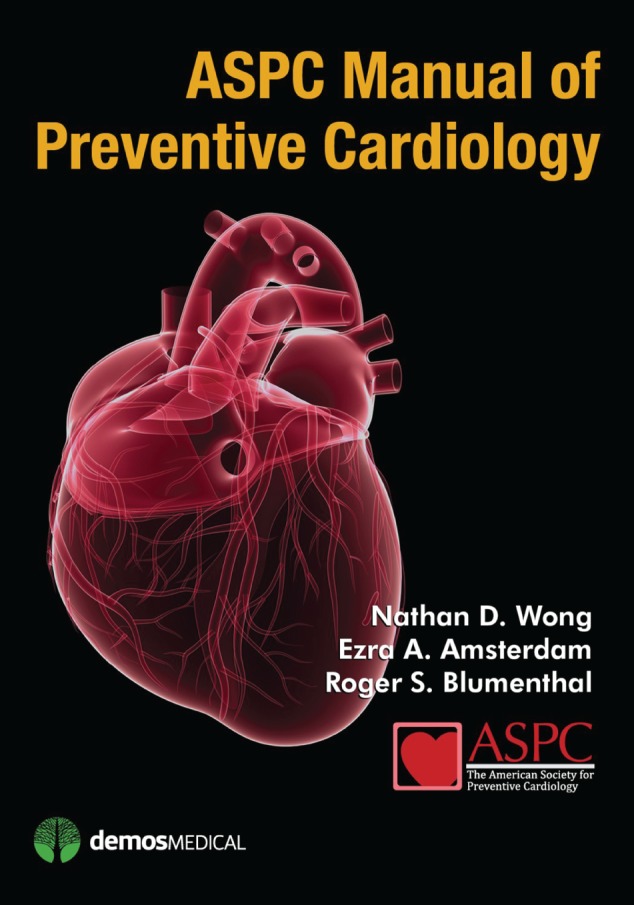The American Society for Preventive Cardiology (ASPC) has as its mission “to promote the prevention of cardiovascular disease, advocate for the preservation of cardiovascular health, and disseminate high‐quality, evidence‐based information through the education of healthcare clinicians and their patients.” The origins of ASPC date back to a working group of National Heart, Lung, and Blood Institute scientists who recommended curricula be developed to facilitate medical‐school teaching and research aimed at preventing cardiovascular disease (CVD). Sixty institutions (48% of US medical schools) were among the 13 classes receiving National Institutes of Health Preventive Cardiology Academic Awards (PCAA) from 1979 to 1996. PCAA awardees have written preventive‐cardiology textbooks and served in various leadership roles within the American College of Cardiology and American Heart Association (AHA).1
The ASPC was launched in 1985 under the guidance of Dr. Joseph Stokes III (Figure 1) and was designed initially as a forum for the dissemination of PCAA programs. Dr. Stokes was renowned for a litany of contributions to medicine: He served as a co–principal investigator on the Framingham and other studies; he was founding dean of the University of California, San Diego Medical School and on the faculty at Boston University; and he served on the National Cholesterol Education Program and CVD Epidemiology and Prevention councils. Dr. Stokes passionately promoted education, research, and clinical practice within the field of preventive cardiology.1
Figure 1.

Dr. Joseph Stokes III.
The ASPC was further expanded in 1990 when Dr. Richard Carleton (1931–2001), who had a PCAA from 1982 to 1987 and was known for his work with the Pawtucket Heart Study in Rhode Island, became its first president. The scope of CVD prevention during that time was expanded to include population studies, blood pressure, lipids, nutrition, exercise, and clinical cardiology. The AHA Council on Preventive Cardiology was created and quickly merged with the AHA Council on Epidemiology, forming the AHA Council on Epidemiology and Prevention, now in its 55th year. Dr. Dennis M. Davidson (1939–2014), also a preventive cardiologist pioneer, served as ASPC's second president and was the first director of preventive cardiology at the University of California, Irvine, beginning in 1984. He also led one of the PCAAs (which, incidentally, helped to bring Nathan D. Wong, PhD, to the faculty in 1988).
Since 1994, the ASPC has presented annual debates at the AHA Council on Epidemiology and Prevention scientific sessions. The debates have focused on topical matters, with selected subjects of these debates shown in Table 1. Until relatively recently, the ASPC traditionally had a presence limited to the debates at the AHA Council on Epidemiology and Prevention meetings as well as dinner/business meetings/gatherings of an erudite group of prevention experts. In 1998, Le Jacq Communications, with editor‐in‐chief Ezra Amsterdam, MD, also one of the first ASPC presidents, launched the journal Preventive Cardiology. The journal became an important forum for publishing not only key research and position papers in preventive cardiology, but also the annual debates and presidents’ messages for the society. Later, in 2011, the journal Clinical Cardiology, published by Wiley, succeeded Preventive Cardiology as the official journal of the ASPC.
Table 1.
Topics of selected American Society for Preventive Cardiology annual debates
| ATP cholesterol education guidelines |
| Alcohol and CVD |
| Hypertension |
| Triglycerides |
| Should I be using current exercise guidelines? |
| Does CAD have an infectious etiology? |
| Noninvasive screening for coronary calcium |
| Genetic testing is critical for coronary heart disease risk assessment |
| Control of blood sugar is more important than control of lipids and blood pressure |
| Clinical utility of C‐reactive protein |
| Low‐carbohydrate, high‐protein diets |
| Should everyone age ≥55 years with preexisting CVD be prescribed a single daily pill (the polypill strategy)? |
| Cost‐effectiveness issues related to LDL‐C lowering |
| How early to begin cholesterol screening and treatment |
Abbreviations: ATP, Adult Treatment Panel; CAD, coronary artery disease; CVD, cardiovascular disease; LDL‐C, low‐density lipoprotein cholesterol.
In 2008, former ASPC presidents Douglas Schocken, MD, Peter Wilson, MD, and Nathan Wong, PhD, sought to transform ASPC into a more inclusive organization. Consequently, Compass Management, with its proven track record in developing the National Lipid Association, was recruited to manage ASPC. The revitalized ASPC was envisioned to best promote preventive cardiology through an outreach beyond its “ivory tower” of academicians to a broader base of healthcare providers, educators, and industry experts in the community who ultimately are involved with much of the research, education, and healthcare in preventive cardiology. Thus began a series of scientific meetings that would provide outreach and increase exposure of the ASPC to the broader scientific and medical community. The Orange County (California) Symposium on Cardiovascular Disease Prevention, now in its eighth year, started in 2009. The flagship annual meeting in Boca Raton, Florida, now in its fifth year, started as the Women's CVD Prevention Conference in 2012 and has now expanded to become the national congress of the ASPC, attracting more than 300 attendees in 2015. Other national efforts included joint symposia at the American Society of Hypertension and at several Pri‐Med primary‐care update meetings. In addition, the ASPC, beginning in 2010, for the first time promoted itself internationally through conducting or endorsing joint symposia such as at the Great Wall International Congress of Cardiology in Beijing, the World Congress of Cardiology in Beijing and in Dubai (where a one‐day training course in preventive cardiology was offered), Saudi Prevent in Damman, Saudi Arabia, and for several years now at the World Congress on Heart Disease sponsored by the International Academy of Cardiology. In addition, the ASPC has had a seat as a prevention‐focused organization within the International Council of Cardiovascular Prevention and Rehabilitation as well as the Global CVD Prevention Leadership Council affiliated with the World Heart Federation.
Presented annually (now at the AHA Council on Epidemiology and Prevention meeting), the Stokes Award commemorates Joseph Stokes III, MD (1924–1989), the famed cardiologist and epidemiologist who contributed so much to the field as well as to the ASPC. The award is bestowed on individuals who have demonstrated a lifetime achievement in preventive cardiology. Table 2 provides a list of these awardees. One recent awardee of note was William B. Kannel, MD (Figure 2), former director of the Framingham Heart Study. Dr. Kannel has been credited with popularizing the key risk‐factor contributions of the Framingham Study, establishing the roles of cigarette smoking, cholesterol, and blood pressure as key risk factors for CVD. Current Framingham Heart Study director Daniel Levy, MD, recently said of Dr. Kannel's contributions, “In 1961, with just two words, Bill helped to change our understanding of the underlying causes of heart disease and stroke, the entire field of preventive cardiology was born. Those two words were ‘risk factors.’ They represented a quantum leap in 20th‐century medical thinking. No longer would heart disease be viewed as an inevitable condition that struck people in the prime of life without warning, but rather, there were risk factors underlying the disease, and identifying them would lead to new treatments to prevent the leading killer of men and women in our country.” Dr. Kannel was given the Stokes Award in March 2011, shortly after which he published the proceedings of his acceptance speech, “Sixty Years of Preventive Cardiology: A Framingham Perspective,” in the ASPC official journal Clinical Cardiology, just months before his death that summer.2 Dr. Kannel's legacy has also been recognized by the ASPC by the joint creation in 2014 (by the ASPC and the AHA Council on Epidemiology and Prevention) of the annual William B. Kannel Memorial Lectureship in Preventive Cardiology. Recipients of this lectureship have included Jeremiah Stamler, MD, in 2014, Daniel Levy, MD, in 2015, and Aaron Folsom, MD, in 2016.
Table 2.
Recipients of the Joseph Stokes III, MD, Lifetime Achievement Award in Preventive Cardiology
| 2016 Aaron Folsom, MD |
| 2015 Virgil Brown, MD |
| 2014 Nanette Wenger, MD |
| 2013 Sidney C. Smith Jr., MD |
| 2012 Jeremiah Stamler, MD |
| 2011 William B. Kannel, MD, MPH |
| 2010 Ezra Amsterdam, MD |
| 2009 Lewis Kuller, MD, PhD |
| 2008 Robert Eckel, MD |
| 2007 John Robin Crouse III, MD |
| 2006 Darwin Labarthe, MD, MPH, PhD |
| 2005 Stephen P. Fortmann, MD |
| 2004 Curt Furberg, MD |
| 2003 Elizabeth Barrett‐Connor, MD |
| 2002 Philip Greenland, MD |
| 2001 Michael Criqui, MD, MPH |
| 2000 Shiriki Kumanyika, PhD, MPH |
| 1999 John W. Farquhar, MD and Russell V. Luepker, MD, MS |
| 1998 Gerald Berenson, MD |
| 1997 Thomas A. Pearson, MD, PhD |
| 1996 Elaine Stone, PhD, MPH |
Figure 2.

Dr. William B. Kannel presented with Joseph Stokes III Award by ASPC Past President, Nathan D. Wong, PhD in March 2011.
In recent years, the ASPC has grown dramatically, with expanded platforms of educational and professional programs and bright plans for the future. A list of the past presidents of ASPC is shown in Table 3. The ASPC's endorsement of a key textbook, Preventive Cardiology: A Companion to Braunwald's Heart Disease (Blumenthal RS, Foody JM, Wong ND, eds.; Elsevier, 2011) was a key initial offering promoted to its membership. At the 2015 annual meeting in Boca Raton, the first one‐day ASPC Experts Course in Preventive Cardiology was offered, with each attendee receiving a copy of the first ASPC Manual of Preventive Cardiology published in the same year (Wong ND, Amsterdam EA, Blumenthal RS, eds.; Demos Medical Publishing, 2015; Figure 3). The same year saw the introduction of posters, helping to bring attendees from six nations. And currently in 2016, ASPC has received applications for and accepted its inaugural class of fellows of the ASPC (FASPC), which will provide the first official fellowship certification in preventive cardiology for those who have a record of dedication, service, and accomplishment in the field. Plans are now in place for exploring further expert and certification courses as well as developing Preventive Cardiology Board and Maintenance of Certification efforts in collaboration with the American Board of Internal Medicine, American College of Cardiology, and other organizations.
Table 3.
Past presidents of the American Society for Preventive Cardiology
| 2014–2016 Laurence S. Sperling, MD |
| 2012–2014 Stephen Kopecky, MD |
| 2010–2012 Nathan D. Wong, PhD |
| 2008–2010 Peter Wilson, MD |
| 2006–2008 Douglas Schocken MD |
| 2005 Lori Mosca, MD |
| 2004 Michael Miller, MD |
| 2003 Frank Franklin, MD |
| 2002 Norman Lasser, MD |
| 2001 John Crouse, MD |
| 2000 Francisco Fuentes, MD |
| 1999 Christine Williams, MD |
| 1998 Marian Limacher, MD |
| 1996–1997 Robert Wild, MD |
| 1995–1996 Henry Black, MD |
| 1994 Patrick McBride, MD |
| 1992–1993 Philip Liebson, MD |
| 1991 Ezra Amsterdam, MD |
| 1990 Dennis Davidson, MD |
| 1989 Richard Carleton, MD |
Figure 3.

ASPC Manual of Preventive Cardiology (2015).
The future is indeed bright for the ASPC. We will continue to be a leading organization in preventive cardiology, serving as the bidirectional conduit to other related organizations, globally providing resources and support, and facilitating wide‐ranging efforts in preventive cardiology.
Wong ND, Sperling LS and Baum SJ. The American Society for Preventive Cardiology: Our 30‐year legacy, Clin Cardiol 2016;39(11):627–630.
This article is based on a lecture provided by Nathan D. Wong, PhD, Past President, American Society for Preventive Cardiology, at the American Society for Preventive Cardiology Scientific Sessions, July 2015, in Boca Raton, Florida.
Conflicts of interest: The authors declare no potential conflicts of interest.
REFERENCES
- 1. Michael M. American Society for Preventive Cardiology. Prev Cardiol. 2005;8:186. [Google Scholar]
- 2. Kannel WB. Sixty years of preventive cardiology: a Framingham perspective. Clin Cardiol. 2011;34:342–343. [DOI] [PMC free article] [PubMed] [Google Scholar]


